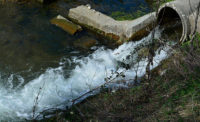Less expensive, more flexible vision systems are appealing to processors

While the state of vision systems may not have vastly shifted over the last few years, the hardware is certainly less expensive today, and the systems are much smarter and cost-effective.
“It’s more attractive to processors to look at vision systems now,” says Colin Usher, research scientist for Georgia Tech Research Institute (GTRI), in Atlanta. “If the machine is run properly, then it brings great benefits to the processing line.”
Vision systems utilize cameras to look at meat and poultry products for quality, food safety standards, labels, packaging, and foreign materials. In short, they can offer quality control and immediate feedback and identify problems as soon as they occur – faster even than manual inspections.
“Employees can get distracted on the inspection line or are stretched too thin to respond immediately,” notes Usher. “A plant might have only one inspector now, not two, for example; and employees can take a longer time to detect and capture defects than vision systems.”
Imaging systems exist today that use differences in the light spectrum to detect anomalies in the product. “There is artificial intelligence [AI] that goes along with these imaging systems that analyzes this data, and the technology is able to detect quality defects like woody breast, bruises, bones, etc.,” says Rafael Rivera, manager of food safety and production programs, U.S. Poultry & Egg Association, Tucker, Ga. “It is also capable of identifying foreign material such as wood, plastic, and metal.”
This technology can either replace or complement existing quality control and foreign material prevention systems, says Rivera. “It has the capability of readily adjusting it to specific needs, whether quality or food safety,” he says.
Computing capability has led to opportunities to expand this technology. “With AI, you can collect data in real-time, and it generates enormous amounts of data,” says Rivera. “You have to account for data storage and computing capabilities in order to quickly receive this data and have the ability to make decisions.”
However, vision systems still tend to be rigid, especially when designed around a product, notes Usher. “So, if there are changes in the products being examined, it requires a new algorithm for the system, which can otherwise be somewhat rigid and inflexible,” he says.
Some new AI systems are adaptable to multiple product changes, though.
“If the product going through the system is different, then we still need people to tell the system, and they don’t always do that,” Usher explains.
While vision systems deal with high-tech solutions, they also need basic maintenance. “When it comes to installing and operating a vision system, owners need to understand all aspects of the system,” says Usher. “They need to clean the glass, for example, because it can get foggy or splashed with water, maintain and operate the system and learn and gain the expertise to run it.”
If the system goes down, there needs to be a backup. “Processors will need workers to step in or stop the entire process,” says Usher.
Fortunately, vision systems are typically pretty user-friendly to run. “It depends on the complexity of the system, though,” he notes. “If the products regularly change that go through the system, unless the vision system can detect the changes, then the technology will look at the ‘wrong’ product or will require complicated camera data interfaces.”
AI is becoming more flexible in these systems, as long as processors can also be flexible with their internet connections. “Some systems require internet connectivity to the cloud,” says Usher.
However, agriculture is lagging behind the food industry in connecting to the cloud. “Some companies are limiting their capability because they don’t want to look at cloud platforms as a solution,” says Usher.
Looking for a reprint of this article?
From high-res PDFs to custom plaques, order your copy today!








